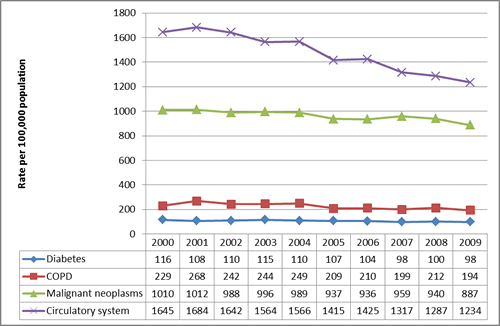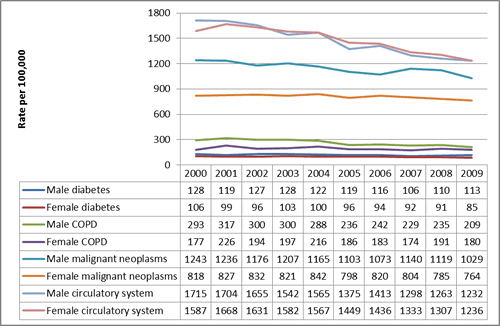Indicator 25: Non-communicable diseases
| Indicator is fully reported? |
Yes. For the most recent published data, see www.health.govt.nz/publication/mortality-and-demographic-data-2009. Data is also available on request from the Ministry of Health. |
| Type of indicator |  Outcome indicator Outcome indicator |
| Our findings |
How deaths are categorised The causes of death can be organised into three groups. Death can occur from:
Deaths from non-communicable causes can be prevented by universal or targeted interventions that governments can introduce. Good quality data is needed to help set priorities for public spending to prevent deaths from non-communicable causes, or to decide whether resources would be better used to decrease deaths from external causes. Data is also needed to know whether any interventions are effective. The types of deaths discussed here Deaths from non-communicable diseases made up 21 of the top 25 causes of premature death reported by the Global Burden of Disease Study 2010. The category of non-communicable diseases includes deaths from conditions such as ischemic heart disease, cancer, stroke, chronic obstructive pulmonary disease (COPD), Alzheimer’s disease, congenital anomalies, diabetes, and chronic kidney disease.[2] Most chronic or long-term conditions are non-communicable diseases.[3] Figure 1 shows mortality rates of people aged 60+ for four non-communicable diseases – diabetes,[4] COPD,[5] malignant neoplasms (cancer),[6] and diseases of the circulatory system.[7] It shows that mortality rates decreased to varying degrees from 2000 to 2009. Figure 2 shows the data for men and women. Overall, the rates for each disease decreased from 2000 to 2009 even though the rates fluctuated from year to year. |
| How entities use the data |
The Minister of Health’s expectations for district health boards for 2012/13[8] included a focus on actions to better manage long-term conditions. The health targets for non-communicable diseases include older people.[9] A description of the Ministry’s work on:
Publications and resources on cardiovascular disease can be found at www.health.govt.nz/our-work/diseases-and-conditions/cardiovascular-disease. The Ministry of Health does not have a specific work programme for preventing, diagnosing, and treating COPD.[10] However, smoking is the primary risk factor for COPD[11] and the reduction of smoking rates is a health target.[12] The Ministry provides information for people with COPD at www.health.govt.nz/your-health/conditions-and-treatments/diseases-and-illnesses/chronic-obstructive-pulmonary-disease. |
| Entity responsible for this indicator |
Ministry of Health (lead agency). |
Figure 1: Mortality rates per 100,000 population for people aged 60+ for selected non-communicable diseases, 2000-09

Source: Ministry of Health.
Figure 2: Mortality rates per 100,000 population for men and women aged 60+ for selected non-communicable diseases, 2000-09

Source: Ministry of Health.
[1] The Global Burden of Disease Study 2010 includes maternal, neonatal, and nutritional causes of death in the communicable diseases category. More information about the study is available at www.healthmetricsandevaluation.org/gbd/publications/policy-report/global-burden-disease-generating-evidence-guiding-policy
[2] www.healthmetricsandevaluation.org/gbd/country-profiles. Click on New Zealand to read the report for our country.
[3] Professor Nick Mays (2013), Reorienting the New Zealand Health Care System to Meet the Challenge of Long-Term Conditions in a Fiscally Constrained Environment, page 8, www.victoria.ac.nz/sacl/about/cpf/events/affording-our-future-conference-2012/papers.
[4] Diabetes ranked eleventh in the New Zealand GBD profile.
[5] COPD ranked seventh in the New Zealand GBD profile. COPD includes chronic bronchitis and emphysema, which are terms that are no longer used (see www.who.int/respiratory/copd/definition/en/#).
[6] The GBD profile reports on cancers separately. Please refer to the report for details. See www.nlm.nih.gov/medlineplus/cancer.html for other words used to describe cancer.
[7] The GBD profile reports types of circulatory diseases separately. Please refer to the report for details.
[8] Please read Madrid indicator 37 for further information about the expectations.
[9] www.health.govt.nz/new-zealand-health-system/health-targets/2012-13-health-targets/health-targets-2012-13-more-heart-and-diabetes-checks. Information about all the health targets is available at www.health.govt.nz/new-zealand-health-system/health-targets/2012-13-health-targets. Results are published at www.dhbsharedservices.health.nz/Site/Current-Issues/Performance-Results-Jun-2012.aspx.
[10] It is not listed under “our work” on the Ministry’s website (www.health.govt.nz/our-work) or the “diseases and conditions” page (www.health.govt.nz/our-work/diseases-and-conditions).
[11] Cancer Society of New Zealand (2009), The Health Promotion Action Plan: 2009-2012, pages 16-17, www.cancernz.org.nz/assets/files/info/Health%20Promotion/HP_ActionPlan_May28_2009-2012.pdf
[12] www.health.govt.nz/new-zealand-health-system/health-targets/2012-13-health-targets/health-targets-2012-13-better-help-smokers-quit.

